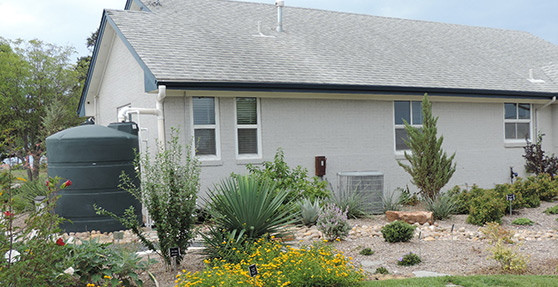If you’ve clicked around on our website at all, you’ve probably come across terms and phrases that are unfamiliar to you when it comes to rain harvesting. You might have also noticed that we are passionate about the topic, and love to educate the world on anything and everything related to rain harvesting. And since there’s only so much space under product listings, we figured we’d occassionally take the time to further explain rain harvesting here on the blog.
Today, we’re going to take a look at “wet” systems and “dry” systems. First of all, note that each of these systems refers to a set-up where the catchment tank is above ground. Here are the differences:
Wet Systems A “wet” rain harvesting system is most often used for a large building where the collection tank is far from the catchment area. In such cases, the pipes that carry the water to the tank are put out of sight underground. Once the pipes reach the tank, they come back above ground and connect to a riser, which allows the water to flow into the tank.
With gravity at play, there will always be a little bit of water left in the underground pipes – there will never be enough water pressure to flush every drop into the tank – hence the term “wet” system. And since stagnant water is bad news, these systems must have a drain mechanism to allow that last little bit of water to exit the system.
Here is an example of a “wet” system (notice that the pipe that leads to the tank comes from underground):
Dry Systems A “dry” system typically has a simpler set-up and is generally found on a structure with only a couple of downspouts. The collection tank in this case is also usually found right next to the catchment area, so there’s no need to run piping underground. With all pipes above ground, gravity is able to empty every drop of water into the tank – hence the term “dry” system.
Here’s an example of a “dry” system (notce how the downspout leads directly to the top of the tank):
So, which one is superior, you ask? While it really depends on the layout of the property and the size of the catchment area you are working with. We greatly prefer “dry” systems, even though “wet” systems are more aesthetically pleasing (with all of the piping underground). Since there’s no need for a drain in this type of set up, you’re able to make use of more water than with the “wet” system. The good news is that with the right equipment, you can have the best of both worlds! In-ground First Flush Water Diverters allow “wet” systems to become “dry”systems by ensuring that the diverted water and the water that would normally remain in the pipes empties out:
Thus, you can have the piping underground and allow the pipes to run dry. It’s a win-win!
Still have questions? Be sure to connect with us on Facebook, Google +, or LinkedIn. We would be glad to help you!




First, thanks for explaining wet and dry rainwater catchment systems. I think either one would be a good idea, and like you said it just depends on the layout of your house or yard. However, couldn’t the water tank itself be underground? Then you could have a dry system without having to worry about the tank being too close to your home or being an eyesore. I guess the only downside would come when trying to get water out of the tank.
Deprecated: Function get_magic_quotes_gpc() is deprecated in D:\Inetpub\vhosts\rainharvest.com\httpdocs\blog\wp-includes\formatting.php on line 3603